An excellent interior solution can be a tile under a brick for interior decoration. A wide color gamut and the possibility of homogeneous or combined cladding makes it possible to embody many design ideas. But in brickwork there are features that should be taken into account when choosing imitating her tiles and planning repair work.
Practical and elegant brick is one of the most ancient building materials. But, alas, new technologies come to replace the old technologies, so buildings erected from the real brick and preserved to the present day in pristine form can already be considered a rarity. But there were many facing materials, including imitating bricks. And if they are actively used to finish the facades, interior interior In a similar style, it is still a rarity, at least in Russia, where other design motives are traditional.
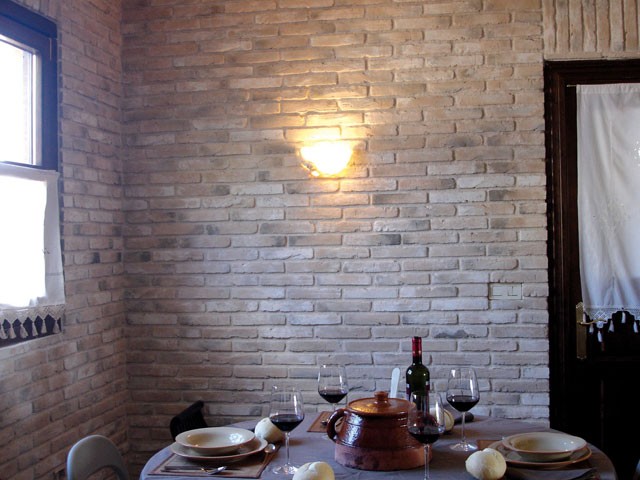
Bright brick in the interior.
In the west, fashion for a sort of gloomy appearance of residential premises has arisen quite a long time. Extensive studio apartments with brick walls illuminated by panoramic windows, look unusual, but quite attractive. Few people decide to give their homes so severe appearance, despite the fact that it is not necessary to build brick house. After all, there is a tile under the brick for interior decoration, which will easily transform the room, implacing the brickwork.
Possible design techniques
Fears to give such a bold designer running their own house. The view of the caasemap is groundless, because there is always a compromise. If imitation brick masonry It seems very tempting, but doubts remain better not to risk, making up the whole room with tiles. To begin with, it is enough to bind one of the walls. Excellent if there is a niche in the room, then you can start with it, having thought over the overall design concept in order to successfully compose different interior solutions.
As for asymmetric design with tile under the brick of corners and other wall fragments, this is definitely a matter of taste. Reception used to simulate protruding places from under the stucco of old brickwork looks original, but not natural. However, if the idea is exactly as follows - why not try to translate it? Conditioning angle, a wall niche or mirror can be a very successful find, provided that organic introduction of this element in the interior of the entire room.
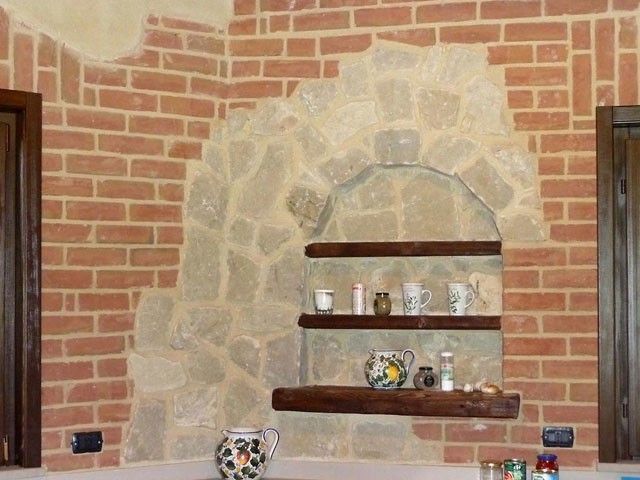
Combined asymmetric finish.
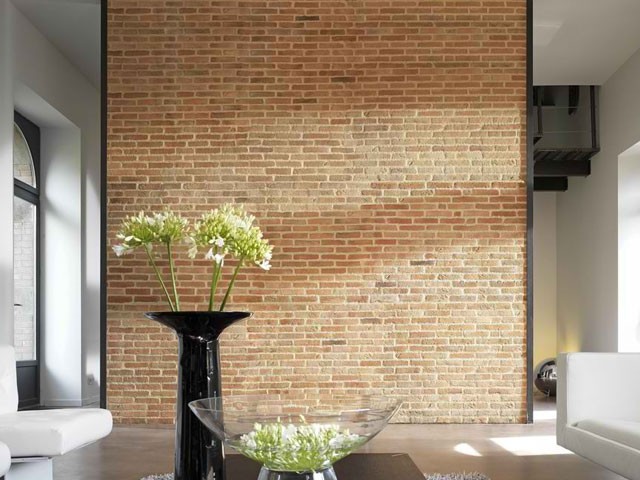
Particularly preferred combined finish, if there is a furnace or fireplace in the room. Fragmental facing with tile under the brick on the walls is perfectly combined with a brick fireplace or a stove, the surface of which can be separated by a tile if they are laid out of the material that is inappropriate to the interior. Meanwhile, in this situation, completely brick walls look too appropriate, on their background the fireplace is simply lost. The combination of different facing materials, on the contrary, allows you to allocate interesting design elements.
Another way to avoid excessive gloomy - right choice colors. Fans of this style prefer to use traditional brick. However, it is not necessary to adhere to traditions so strictly. Even if you wish to bore the walls of red bricks, you can choose the shade of the breather. And it is better to familiarize yourself with the containers offered by the manufacturers of the color gamut tile under the brick for interior decoration, as a result, conservatism can retreat before the possibility of a bold experiment.
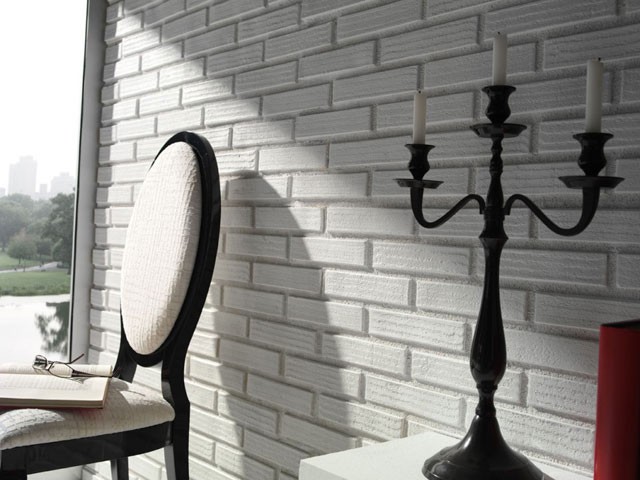
White brickwork.

Colored brickwork.
Types of imitating brick tiles
Interior decoration does not imply direct impact on the used construction Materials The temperature differences and other natural phenomena, but approach the selection of the facing tile, is still carefully. In the masonry of the brick tile there are some differences from working with a standard cafeter, monophonic or with an ornament. The thoughtful design of the room needs to be solved, a complete imitation is required, or quite remote similarity. After all, in size, such a tile is produced in two types:
- in the form of one brick;
- in the form of several laid out rows.
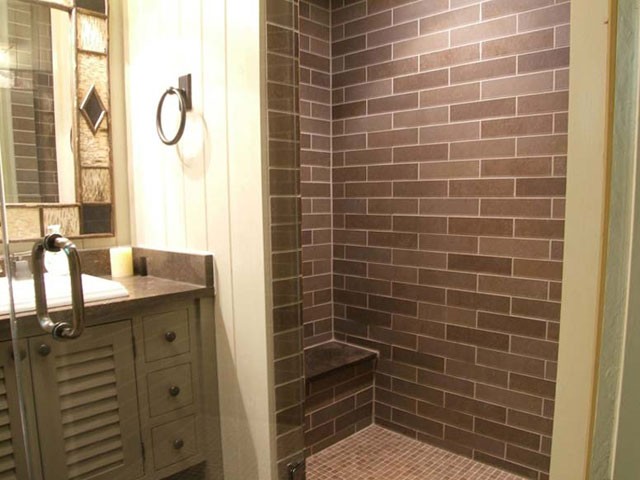
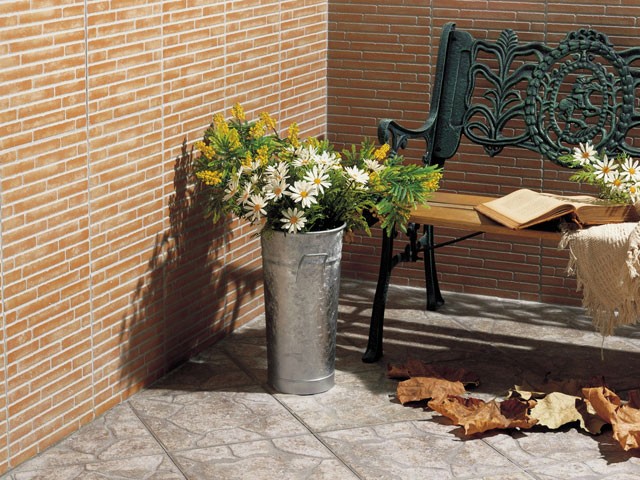
In the latter case, the laying is much easier due to the large sizes of individual tiles, but in the places of their combination, the "chess" principle of brickwork is violated. This does not mean that such a tile should definitely reject. Sometimes the wall, lined with tiles under the brick without signs of traditional masonry, looks quite impressive. However, when this species is selected, it is also worth remembering that the suture imitation lines may be too subtle, which is why fragility is raised in these places.
Although the strength depends on the material from which the tile under the brick for interior decoration is made:
- clinker;
- ceramics;
- polymer cement;
- gypsum.
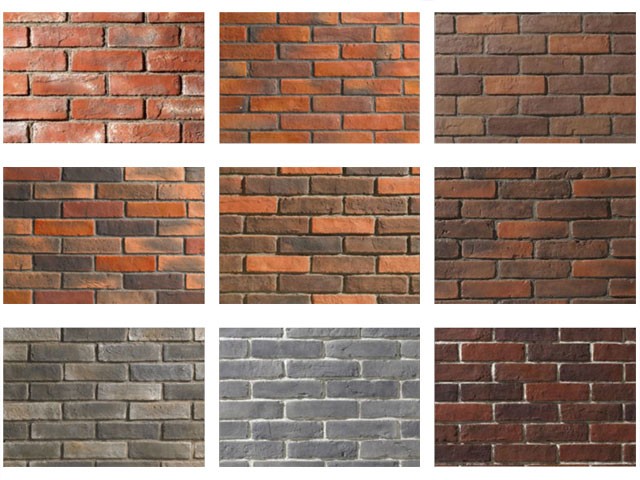

Clinker tiles are designed to finish facades, but is often used for facing internal premises. Made by firing from shale clay, it is solid and resistant to different kinds of adverse effects. Clinker should prefer if the room is planned to repair seriously and for a long time. This tile easily falls on any surface and perfectly keeps in the future. Flower selection amazing imagination. But, like when buying bricks, it is better to immediately order all the necessary volume due to the color and textured uniqueness of each batch.
Other materials are significantly inferior to the wedge in characteristics and price, although they look in the interior not worse. The purchase of ceramic, polymer-cement or plaster tiles under the brick for interior decoration allows you to make a decent wall cladding, avoiding extra expenses. It is only necessary to take into account the fact that for facing fireplaces, furnaces and even the kitchen apron is better to use refractory ceramics and the corresponding glue. The approach to the bathroom finishing should also be serious, since the tile will be constantly exposed to moisture. Therefore, bathrooms are recommended to be tinted with protective coating materials.
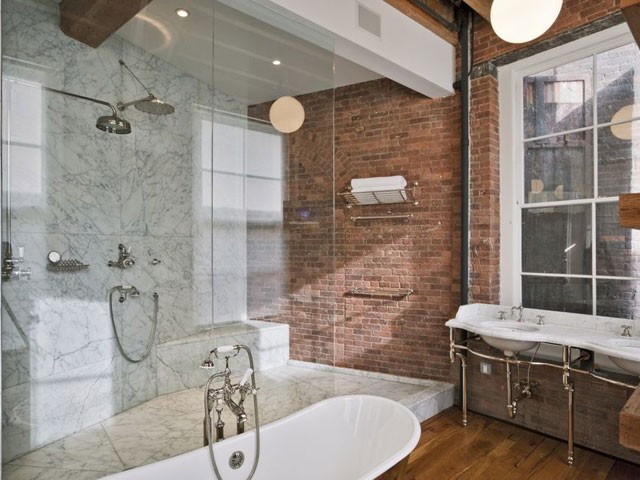
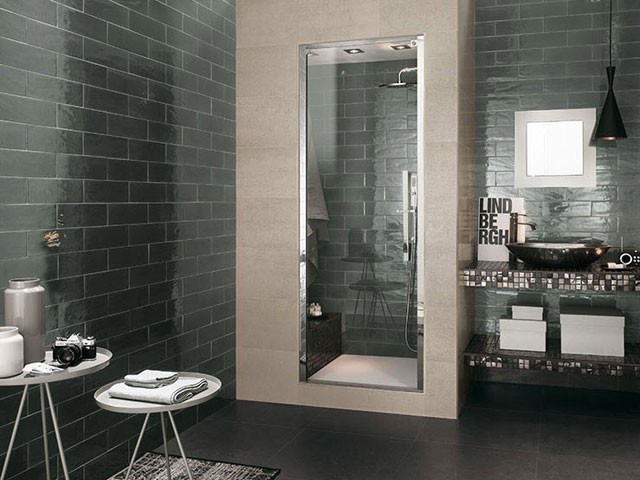
The fact that the tile under the brick should certainly be matte and textured - delusion. Brick interior Still a very unconventional solution remains, so why not experiment with its implementation and with these characteristics? The textured imitation of the collapsed red brick is one of the possible options. However, you can choose a smooth matte tile, and with a glossy coating. A brickwork with a gloss looks less natural, but in a thoughtful interior may look interesting and original, and most importantly - appropriate.
Nuances styling
If we are talking about a brick tile for interior decoration that imitating several rows, you should follow the traditional tile laying technology. Here will sharpen attention on the features of working with a tile in the form of one brick. And the main nuance, embarrassing inexperienced tiler - the chess procedure for placing elements. After all, when they are located strictly over each other, the problem of alignment of the series is solved by the use of special crosses placed in each corner. But how to insert crossbars when simulating real brickwork?
Instead of familiar cruciform devices, you can use only three teeth, if you manage to detect such on sale. Otherwise, remove one of them from each cross will be too troublesome, it is better to use another reception. It is not necessary to insert crosses in the corners of the alignment. You can simply stick them with one end between the tiles, placing pairs for reliability on each side close to the joints. It will provide smooth laying both in the traditional and chess location of tiles in the rows.

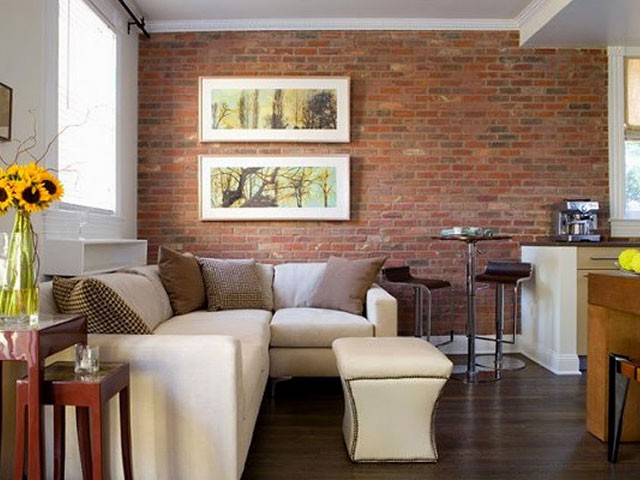
Another important feature is the size of the gaps that are also regulated by cross. So that the tile under the brick for interior decoration looked naturally, the gaps between the elements should be significantly larger than when laying the usual tile on the walls. Therefore, crosses should choose large, allowing reliably to simulate real brickwork. However, here are also possible options. After all, we experiment, and absolute accuracy is not always the goal of an embodied concept.
In case of achieving naturalness, it is still desirable, it is worth following and one more advice. It concerns the grout, which is usually chosen under the color of the tile or, on the contrary, in contrast. But in this situation it is easier to do without a special mixture, pouring the seams cement mortar or tiled glue, because it should look like natural brickwork. Happened? So, all!
Brick never came out of fashion. Tile for interior decoration under the brick or for the facade of the house, remains popular at all times. To work indoors, it is not often possible to apply a real brick, as it has a large volume and mass, and it has a relatively high price. In addition, it is quite problematic to make high-quality masonry and to decrease the seams, without at least some experience of such works. New technologies in construction allow you to get a similar result, with the help of other, more suitable for the internal finishing of materials. The possibilities for facing the premises have become more diverse. Many color schemes, sizes and types of facing will allow you to fit into any designer idea. But there are always nuances in choosing tiles under the brick.
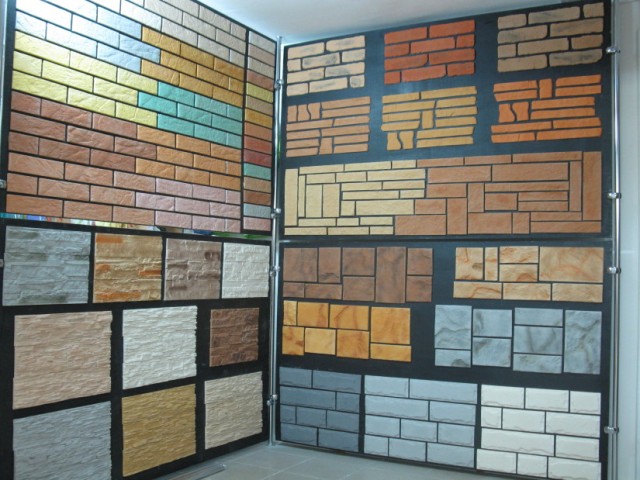
Despite the fact that the tile under the brick for interior decoration will not be subjected to a strong temperature drop or subjected to another climatic effect, as a facade finish, it is worth carefully treating her selection. An ordinary tile differs in the method of laying from brick tiles. When choosing the design of the room you need to decide which imitation is required. Elements for masonry under the brick for interior decoration can be performed:
- As one separate brick;
- As a stove of several folded folded;
- A drawing on the walls with your own hands is applied.
In the first case, the laying will take longer, but the result is a fairly accurate copy.
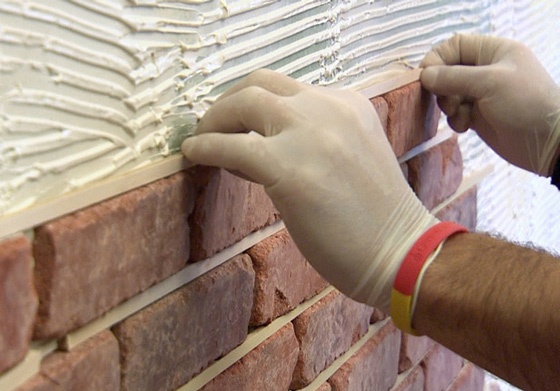
In the second case, the styling occurs faster, since a large tile under the brick on the wall is easier to glue, but there is a chance of losing a chess view of the clock under the brick. This type also remains popular and fits into many interiors, but you need to understand this feature of whole plates in advance. Another disadvantage of such a type of masonry can be called the thickness of the seams under the launch, in the places of their imitation the thickness of the material will be very thin, and according to fragile. Work with whole plates requires greater concentration and caution.
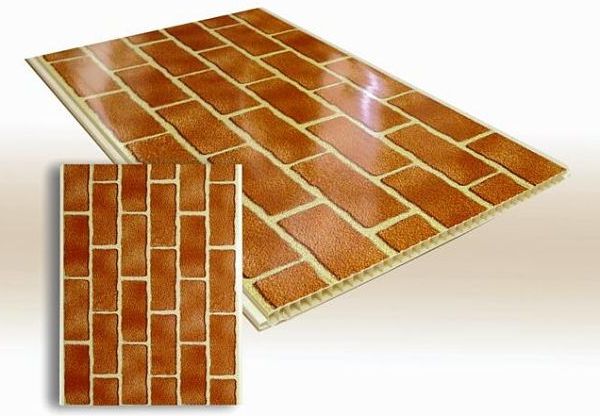
In the third case, there are many imitation options in the form of individual drawings on the wall of I.T.P.

The most common materials for brick imitation are:
- Flexible tile or flexible brick;
- Plaster brick tile;
- Cement;
- Clinker;
- Ceramic.

The decorative tile is well suited for imitation of brickwork for both finishing inside the house and outside. This modern finishing material having not only decorative properties, but also additional characteristics, such as:
- Resistance to atmospheric precipitation;
- Vapor permeability;
- Resistance to the effects of sun rays;
- Resistance to the emergence of microorganisms.
Such material is quite easy to mount on the wall surface. It is especially comfortable to work with rounded surfaces or angles.
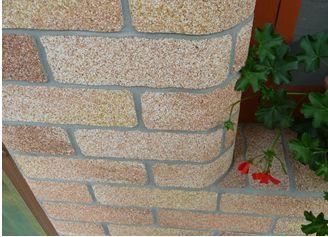
They are used for the interior decoration of corridors, living rooms, kitchens, in basement, loggia (balconies). Tiles are used for both fireplaces of any forms, columns and other architectural forms, regardless of the complexity of forms and bends.
Depending on the designer solution, they can be used to finish all walls or one wall and the creation of "insertion of bricks" in the overall interior. Tiles are made of a thin material, so they can be glued into a certain section of the wall, selecting various shades and shapes.
Installation work for flexible tile
The main advantage of such a material is the method of its installation. To install plates, power tools or other heavy construction devices are required. You will need:
- Shipper for glue;
- Spatula with glue shutters;
- Long construction level is about meters;
- The usual line is about 1 meter long;
- Cord for markup (chopping track);
- Pencil;
- Scissors (durable, sewing);
- Round brush of medium stiffness, for the joints of the seams.
In addition to the main material, you need to handle the walls of the primer. For installation use conventional tile glue. For convenience, you can buy ready-made construction solutions in buckets. Different materials of flexible tiles can have different properties, so you should consult with the seller when buying.
Before installing the walls should be aligned. Flexible tile is thin in size, so it will not work out of irregularities with its help. Prepare the walls as under the finishing finish, it is necessary to apply primer and antiseptic solutions that the fungus would not be formed under the masonry. Such material is polymer, which is why its operation is quite large. After drying the soil, they start assembling. It is necessary to glue the tile at a temperature of at least +5 Celsius, otherwise it may continue to leave the surface due to the weak adhesion of the materials.
Operating procedure:
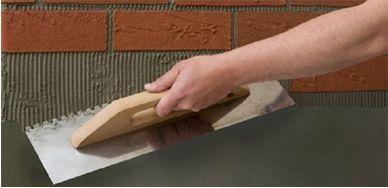
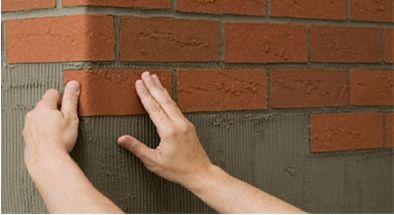
- The seams are produced using a thin brush, moistened with water. It needs to be done almost immediately until the solution has time to grab. Alignment occurs on vertical and horizontal seams.
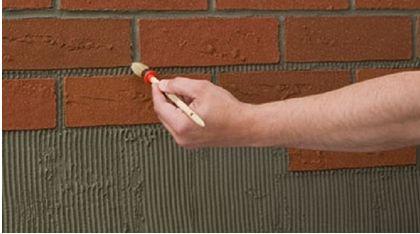
For flexible tiles, you do not need to buy a separate solution for grouting seams, this can be called another advantage of such imitation. Purchase material follows from one party, as well as ordinary brick, so that there were no differences in shades.
Gypsum tile
Gypsum tile facing imitating decorative brick The most profitable price. Products have low weight, so they are not difficult to mount on the wall. It also allows it to use it when finishing the "weak" thin walls, since the load on the wall will not be significantly. However, to achieve good adhesion with the wall, it is necessary to use gypsum-based adhesive. The main disadvantage of such a material can be called bad moisture resistance. Gypsum itself strongly absorbs moisture, so in premises with high humidity it is not recommended to use them.
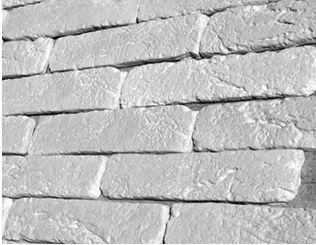
Special additives and solutions are applied to the surface of some simulators allowing the use of gypsum materials even for outdoor decoration facades, but such a material is a bit more expensive. Such types of tiles mount on special glue for outdoor work ("reinforced glue", "glue for complex bases").
Tile under the brick for internal work is produced by various forms, for the convenience of masonry corners. Thanks to such elements, you can not only make the masonry under the brick neat, but also more durable, since the angles will not roll out.
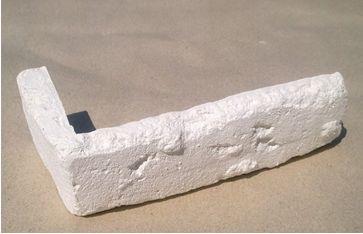
The disadvantage of all solid finishing materials under the brick is the need to purchase solutions for grouting seams. The seams have not only aesthetic function, but also create a solid masonry layer that protects the surface of the walls.
Wall facing under the brick
The main advantage of the stove from Portland cement is a variety of color hammies, as well as low cost. In addition, products made from Portland cement have high physical and mechanical properties. In other words, high strength of material, wear resistance and resistance to temperature drops. Such material can be used even in basement without heating.
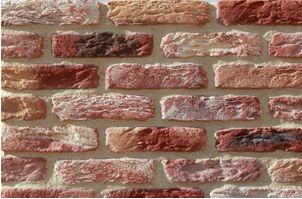
Most often they are manufactured under old brick. For production use cement 400 or 500 stamps. Plasticizers and additives are added to the solution, which increase the strength of the material
The solution is placed in silicone forms, and after setting them decorated for the desired color or texture. For independent manufacture, you can purchase special forms of silicone, you can also make bilps from plaster. The form can be made with your own hands.
Tile from clinker
Clinker slabs have a high price, because of which the use of them as an interior is rare. The clinker has good operational qualities, it is resistant to the effects of the external environment, and therefore it is often possible to meet it in the facade of buildings facades. Application for the interior decoration is advisable if it is necessary to mount it is not a fireplace or oven.

In the manufacture of this material use natural environmental substances. As raw materials, clay are used, which is burned at a temperature of about 1300 degrees. As a result, it turns out a durable material, steady to all types of natural precipitation.
Clinker tiles have good hygroscopic properties. They do not absorb moisture, because of what they have good frost resistance. The strength of the material provides long-term wear resistance of the plates.
The decorative component of such plates is as diverse as physicomechanical indicators. There are many color schemes of materials with different textured drawings that imitate an old interior or a new coating. The surface may be smooth or rough. There are various sizes of clinker plates.
Ceramic facing plates are made of clay and sand. To give color, add various dyes. Such material has no greater weight. (because of which it can be mounted on any walls), has many forms and paints and has the same decorative properties as clinker. The main disadvantage is the fragility of the material. The price of such stoves is not high, but dear materials really look beautiful, because cheap are like an ordinary tile.
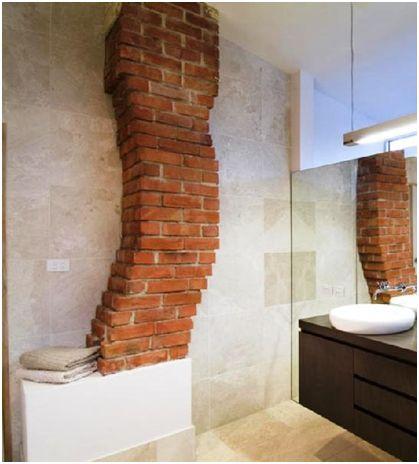
Installation tiles under brick
All rigid types of imitating tiles are mounted approximately equally. Differences only in the use of different adhesive compositions. For work, you need all the same tools as for flexible tiles, but plus it requires a Bulgarian with a diamond round of a stone for sawing plates.
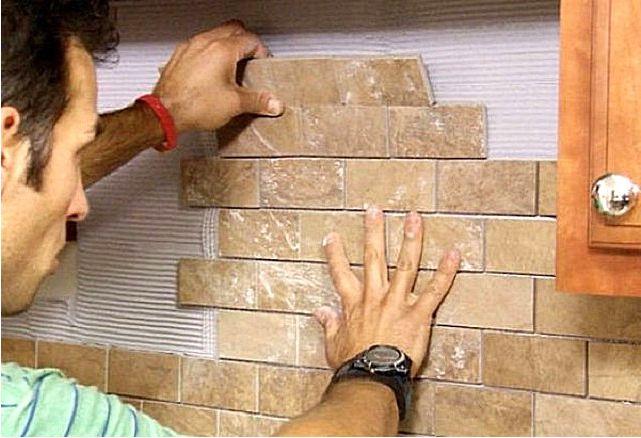
Mounting work is much more complicated, the availability of skills will be an additional advantage. Facing is similar to the masonry of the brick, only if he had a subtle thickness. The order of work is:
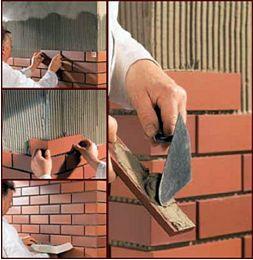
In Europe and the US, the design of walls in the form of bricks has already long remains a popular style in the interior. It looks good such walls in apartments studios with large windows. In our region, few people make such walls, afraid to give them too gloomy and brutal appearance. In fact, this is just an illusion, the walls in the form of bricks look spectacular, practical and just beautiful.
We also offer to read the video material for the installation of plaster tiles under the brick:
Facing tile under the brick for interior decoration is often used for the venue, kitchen, more boldly use such material for living rooms and bedrooms. This material allows you to quickly get a very stylish interior, massively and solid looks and it is relatively inexpensive. More often a brick of traditional colors - red and white, but there is a tile and other shades. Such a material is not enough for small rooms - the brick visually narrows the space, so it is necessary to use it with caution. However, correctly using cladding under the brick, you can achieve a very interesting effect.
Brick is considered one of the most popular finishing materials. Such great success is due to a rich assortment of colors and textures, durability, wear resistance and other performance characteristics, as well as a democratic price. It has long been used not only for construction and external cladding, but also for finishing the interiors. The only minus of natural brick is a lot of weight, so the walls should be durable and withstand such a high load. Brick are faced not only the walls, but also the floor.
To reduce the load, you can use a brick finishing tile, clinker tiles have long been used for the decor of the walls of both external and internal. Outwardly, in its decorative characteristics, it does not differ from its counterpart, but it is thinner, easier and will cost at a more affordable price.
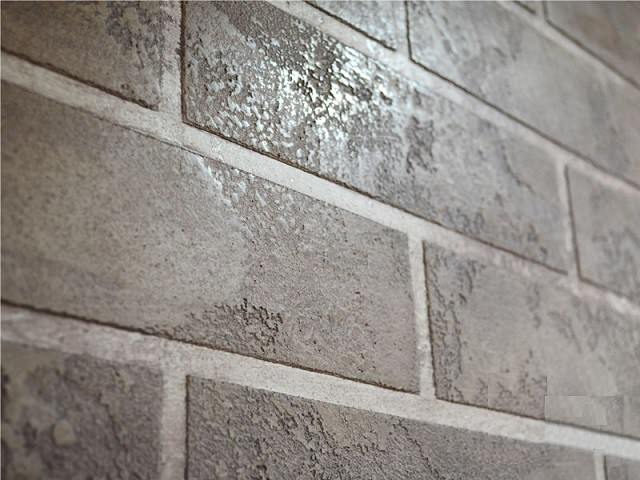
What is the decorative tile under the brick
As a finishing material with imitation of a brick surface, such a tile is produced in several shades.
White brick is often used in the trim of the rooms in the classic style, but also perfectly suitable for rooms in the style of Hi-Tech, Loft or Modern. This is suitable for the decoration of walls in the interiors performed in the country style, Provence. This tile looks good in the house, making the room cozy and warmer. Facing with white brick is perfectly combined with others finishing materials - wallpaper, stone, plaster and clapboard. White color is suitable for any premises and combines with any decorative accessories in the interior. Such a tile looks good, both in bathrooms and kitchens and in a large living room, in which it is taken to gather noisy companies. In addition, a white brick tile is a popular material for landscape design.
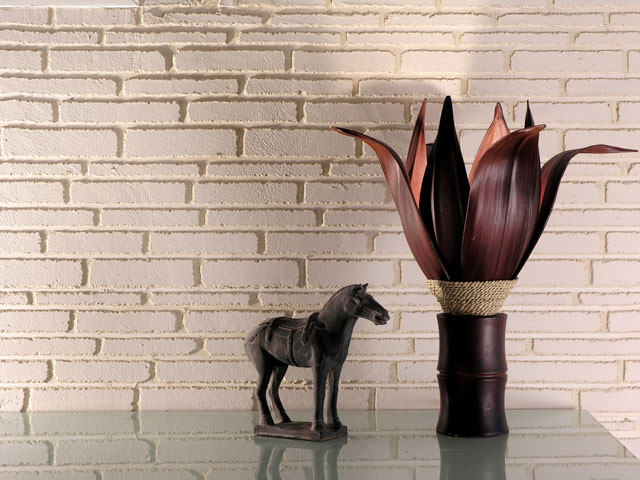
Tile white brick
Tile, imitating classic red-brown brick, is produced in several shades. Its tone depends on the type of clay, from which it is made. The finish of such a tile looks very stylish and bright and allows you to focus on a particular area of \u200b\u200bthe room. Warm shades of tiles bring warm and comfort to the interior. This is the most popular material for the kitchen and hallways.
Imitation of old brickwork. Such a decorative tile in the form of brick is different from their own loose surface and a variety of textures. It is an excellent material for facing fireplaces and walls around them, a brick gives them a beautiful look and fits into the interior even with the most extravagant design.
Glossy brick for kitchen aprons - the material is relatively new and only started to win the market. The brilliant surface of the brick looks unusually and stylish, allowing you to achieve interesting effects in the interior.

Tile red brick
Pros and cons of the tiles under the brick
In addition to small, compared to natural brick, weight, decorative clinker, flexible, etc. The tile has a number of other qualities:
- resistant to chemicals, small damage, temperature differences and other external factors;
- durable in operation;
- it has various textures and tones, which allows it to apply it when lining of walls in a variety of styles;
- easily processed, easy to install and care;
- does not require additional structures in the form of frames or reinforcement;
- it is easy to cut, which allows you to bind sophisticated surfaces, for example, the angles of walls and joints;
- acts as thermal insulator, creating additional insulation;
- stacked on glue solutions that will be needed significantly less than the composition for masonry of ordinary brick;
- externally does not differ from natural brickwork, but it is much more affordable for the price.
Application options
Such materials are used to finish the premises of any destination - offices, residential rooms, commercial premises, restaurants and cafes, hotels, cinemas, etc.
How applied:
- You can most often find brick tiles as edging doors and windows, as well as decorative decoration Mirrors and niches of various shapes and sizes.
- No less popular use of such a finish is a kitchen apron.
- Decorative tile (flexible, clinker, etc.) and other types of materials imitating the brick wall are used to clamp fireplaces in country houses.
- Zoning of premises decorative tile - Winding wall different materials In case of texture or color, you can divide the room to the conditional zones or it is thus distinguished by a specific element of the interior.
- Stylishly brickwork will look like only in one corner of the room, this is the perfect option in case the room is small, and I really want to use the brick in the finish.
- Tile can be combined with plaster and wallpaper.
- With the internal finishing of the room, consider that the brick is not the material that the walls need to be shed completely. The room risks turning into a warehouse or basement. In addition, the red-brown brick in such quantities will look very gloomy.
Types of decorative bricks
Materials that imitate brickwork differ not only on the texture and color, but also the technology on which they were produced.
Clinker tile
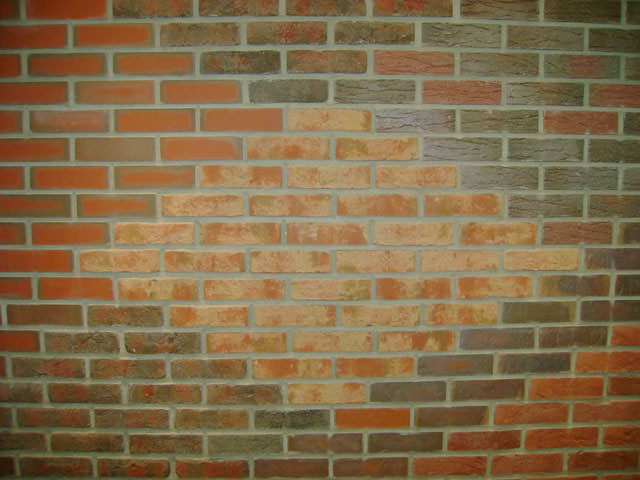
Clinker tile
For the manufacture of this facing material, clay is used - flexible and elastic. It is subjected to burning at a very high temperature - 1100 degrees Celsius. Such processing technology makes the tile is very strong. Clinker tile is so reliable that it is used not only for interior decoration, but also for facing facades. The burned clay with ease repeats all the irregularities and roughness of natural brick masonry and indistinguishable from the brick either on the eye or to the touch. Such a tile, in contrast to the more fragile and vulnerable to external influences, the brick does not destroy and is reliably protected from water, mold, scratches, shocks, etc.
Clinker tile, thanks to its qualities, perfect material For hallways and kitchen, i.e. Places in the house where various incidents can happen most often. Walls, randomly leaning with metal parts of strollers, bicycles or some other large-sized objects, will calmly solve all the tests.
They are not terrible and claws of pets, although, of course, to accustom to pets to sharpen claws about the wall should not.
Clinker tiles to the whole other very economical material.
Flexible tile under brick
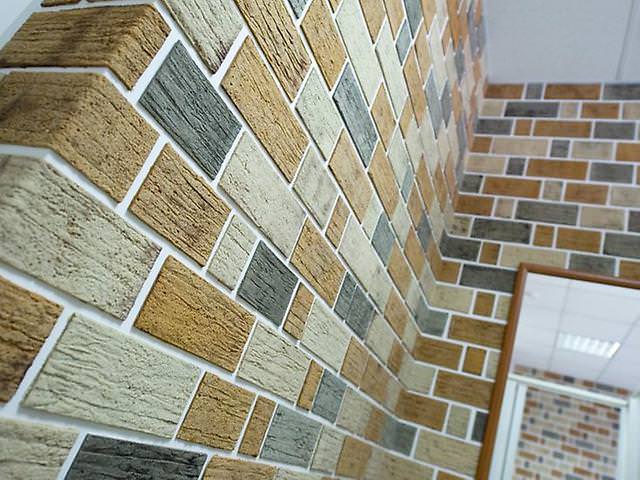
Flexible tile
Such a tile, in fact, resembles the wallpaper - it glues on the same principle. The flexible tile is used to decorate under the brick of such surfaces, which are complex in finishing with other, less plastic materials - semicircular arches, columns, corners, etc. The material is very simple in the installation, for this, there is enough construction glue. One roll usually has dimensions about 0.5x2.5 meters and weigh about 4 kg.
The flexible tile has a pleasant surface to the touch, is considered a good heat insulator. In addition, such material is environmentally friendly, which means completely safe. Flexible tile, among other things, an excellent soundproofer. This material is produced not only with the imitation of a brick surface, but also natural stone.
Whole panels
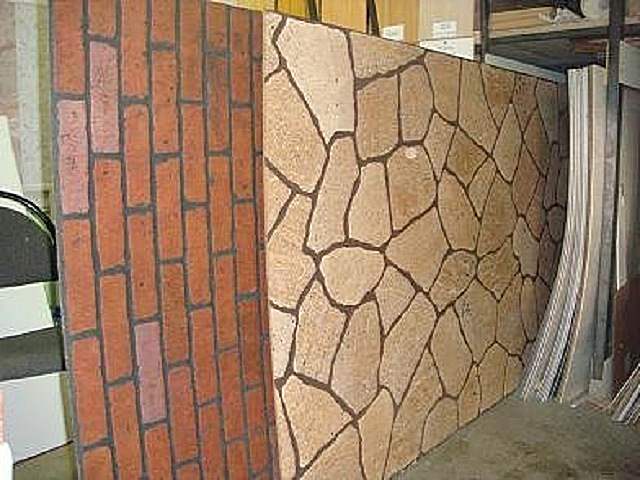
Flexible panels
They have large sizes than clinker tiles, imitate a whole plot brick wall. They are made from polymer cement or ceramic materials. Externally, such a finish though imitates the brick, but it looks less natural due to a large number of repetitive parts.
On the other hand, the use of whole panels is greatly saving time spent on the walls of the walls. Together with a low price of this kind, the material is quite a good option.
Price
Facing with imitation of brick masonry will cost a different price, it depends on the material, operational qualities, complexity in laying, weight, etc. For example, a tile, imitating ancient masonry, will cost more than a simpler and smooth option.
What ways can be issued interior under the brick
Natural way
The use of this method is possible only if the walls of the building are composed of bricks - it is enough to simply clean the wall from all decorative layers. White bricks are obtained after washing, drying and processing by special means protecting the surface from pollution.
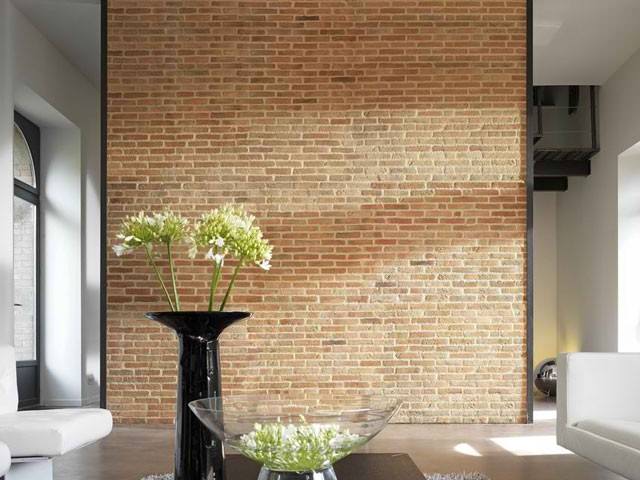
If the walls are built of red bricks, they will have to paint with white paint. However, if it is planned to leave a natural color, you will not have to do anything. If there are small chips and cracks in bricks, they can be eliminated, but they are rarely done, because the notes of the antiquity give the interior a special charm. For this effect, new walls are specially aged.
Decorative
If the walls are not lucky and the walls of the house were concrete, wooden, etc., then various finishing materials are used to achieve the desired effect:
- Facing brick is used for decor of fireplaces, individual walls, angles, arches, windows and doors.
- Clinker tile looks no less believable in the interior, simple in laying and economical.
- Wallpaper with a picture of a brick - the simplest version of the walls. They quickly glue and repair is carried out very quickly, but such an imitation looks cheap and rude.
Features of laying
Tile with imitation of several brick rows is stacked by classical technology. Flexible tile and wallpaper, respectively, glue on the walls as usual, but with a tile in the form of one brick there are several difficulties.
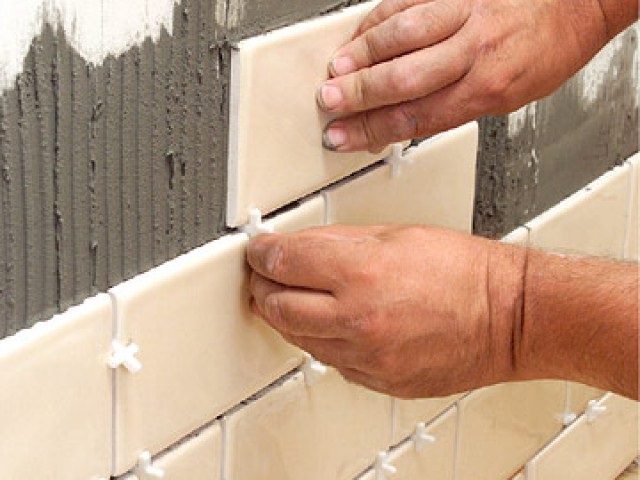
Laying tiles
The most basic problem that arises from those who have come for such a material for the first time is chess laying. If an ordinary brick was used, there were special crossings placed in the corners for marking. Question: How to insert cross in case of simulation?
For marking, special devices with three teeth are used, but such beacons are rarely found in stores, and it's not too comfortable to break down the tooth from each cross. Which exit? Crossings in this case are not set in the corners of the combination of tiles, but between them. The laying will be as smooth.
Crossings regulate and the size of the gaps between the tiles. So that the masonry looked most naturally, the gaps should be much more than when installing ordinary tile. Therefore, choose large cross, so that you can easily simulate a real brick wall.
Grouting, too, does not suit each. If in the case of a tile, use the grout of white or shade to the tile itself, then cement or tile glue is needed.




